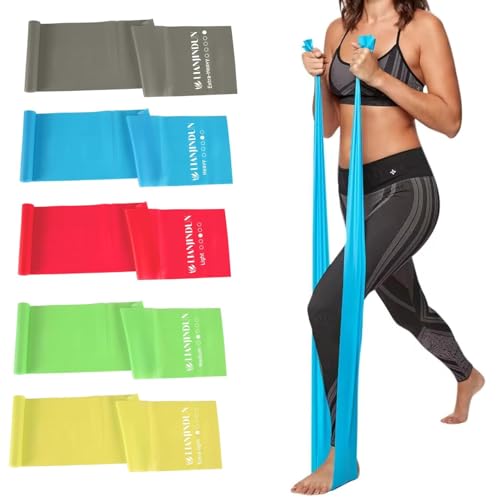Resistance bands have become increasingly popular in the world of fitness – and for good reason.
These versatile pieces of equipment offer a wide range of benefits and can be used in various ways to enhance your workouts. Whether you’re a beginner or an advanced fitness enthusiast, incorporating resistance bands into your training routine can take your fitness journey to new heights.
In this article, we will explore when to use resistance bands effectively to maximize your workout results.
Contents
Benefits of Resistance Bands
Before delving into the specifics of when to use resistance bands, let’s first highlight the numerous benefits they bring to your fitness routine. Understanding these advantages will help you appreciate the value of incorporating resistance bands into your workouts.
1. Portable and Lightweight: One of the key advantages of resistance bands is their portability and lightweight nature. Unlike bulky gym equipment, resistance bands can easily fit into your bag or suitcase, making them ideal for travel or home workouts.
2. Versatility: Resistance bands offer a wide array of exercises that target different muscle groups. Whether you’re looking to build strength, improve flexibility, or increase muscle endurance, resistance bands can be adapted to suit your goals.
3. Joint-Friendly: Unlike some weightlifting exercises that put stress on your joints, resistance bands provide a low-impact workout option. They help reduce the risk of injury while still providing effective muscle stimulation.
4. Scalability: Resistance bands come in various tension levels, allowing you to adjust the intensity of your workouts as your strength improves. This scalability makes resistance bands suitable for individuals of all fitness levels.
Now that we understand the benefits of resistance bands, let’s dive into the specific scenarios where they can be incorporated into your workouts.
When to Use Resistance Bands
1. Warm-Up and Activation Exercises
Before jumping into your main workout, it’s essential to properly warm up your muscles and activate them. Resistance bands can play a valuable role in this phase of your training routine. Here are a few examples of warm-up and activation exercises where you can utilize resistance bands:
– Glute Bridges: Place a resistance band just above your knees and perform glute bridges. The band adds external resistance, increasing the activation of your glutes.
– Clamshells: Loop a resistance band around your legs just above your knees while lying on your side. Open and close your legs like a clamshell, engaging your hip abductor muscles.
– Shoulder Activation: Wrap a resistance band around your wrists and perform shoulder external and internal rotations. This helps activate the rotator cuff muscles before upper body workouts.
Including these resistance band exercises in your warm-up routine can help activate the targeted muscles, improve muscle engagement, and enhance overall performance during your main workout.
2. Strength Training
Resistance bands offer an excellent alternative to traditional weightlifting exercises. They provide continuous tension throughout the movement and activate stabilizer muscles, which may not be effectively engaged with weights alone. Here are a few examples of strength training exercises where resistance bands can be used:
– Squats: Anchor a resistance band under your feet and hold the other end at shoulder level. As you perform squats, the band adds resistance, making the exercise more challenging and engaging your leg muscles.
– Bicep Curls: Stand on a resistance band with your feet hip-width apart and hold the band handles in your hands. Perform bicep curls, keeping tension on the band throughout the movement.
– Lateral Raises: Step on the middle of a resistance band with one foot and hold the band handles in each hand. Lift your arms out to the sides, engaging your shoulder muscles while maintaining tension on the band.
Incorporating resistance bands into your strength training routine can help improve muscle tone, increase strength, and target specific muscle groups more effectively.
3. Rehabilitation and Injury Prevention
Resistance bands are commonly used in physical therapy and rehabilitation settings due to their ability to provide gentle resistance without placing excessive stress on joints. They can be valuable tools for injury prevention and recovery. Here’s how resistance bands can be utilized in rehab and injury prevention exercises:
– Rotator Cuff Exercises: Attach a resistance band to a sturdy anchor point and hold the other end with your injured arm. Perform external and internal rotation exercises to strengthen the rotator cuff muscles.
– Ankle Rehabilitation: Wrap a resistance band around your forefoot and anchor it to a fixed object. Move your ankle through a full range of motion against the resistance band, helping to strengthen the ankle joint.
– Lower Body Activation: Place a resistance band around your thighs, just above your knees, and perform lateral walks or squats. These exercises can help activate the glutes and improve hip stability.
By incorporating resistance bands into your rehabilitation or injury prevention exercises, you can aid in your recovery, improve muscle strength around vulnerable areas, and reduce the risk of recurring injuries.
4. Flexibility and Mobility Training
Stretching and mobility work are crucial components of a well-rounded fitness routine. Resistance bands can be excellent tools for improving flexibility and mobility. Here’s how you can incorporate them into your stretching routine:
– Hip Flexor Stretch: Anchor one end of a resistance band at knee height and stand with the other end looped around your ankle. Step forward, creating tension in the band, and perform a hip flexor stretch.
– Shoulder Stretch: Hold a resistance band with both hands, wider than shoulder-width apart. Raise your arms overhead, feeling the stretch in your shoulders and chest as you pull against the band.
– Hamstring Stretch: Sit on the ground with your legs extended. Loop a resistance band around your feet and hold the ends with your hands. Lean forward, allowing the band to assist in stretching your hamstrings.
Including these resistance band stretches in your flexibility routine can help improve your range of motion, relieve muscle tightness, and prevent muscular imbalances.
Final Words
Resistance bands are versatile, effective, and accessible fitness tools that can significantly enhance your workout routine. Whether you’re aiming to warm up, build strength, recover from an injury, or improve flexibility, resistance bands have got you covered.
By incorporating them into your workouts strategically, as outlined in this article, you can elevate your fitness journey to new heights. So don’t wait any longer—grab a resistance band, get creative, and start reaping the rewards of this amazing piece of equipment.
Other Helpful Resources
- Can Resistance Bands Replace Weights: A Comprehensive Guide
- What Type of Resistance Bands Should I Buy? The Ultimate Guide to Choosing the Right Resistance Bands
- The Ultimate Resistance Band Workouts For Muscle Gain
- The Top Four Benefits of Working Out With Resistance Bands
- Benefits of Resistance Bands vs Free Weights: What Should You Choose?




